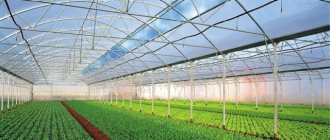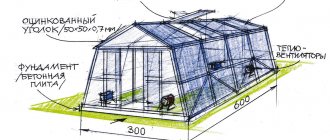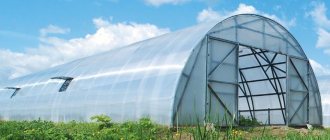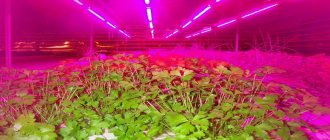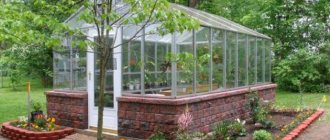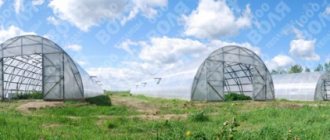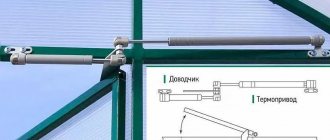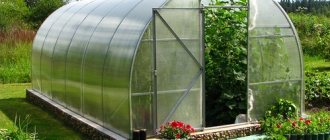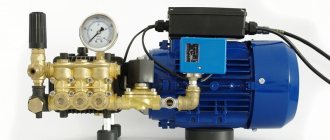Many experienced gardeners who own a plot of land are thinking about growing crops on a production scale for further sale on the commodity market. But often, one garden is not enough to create your own business. In addition, when working in open ground, you may encounter a number of problems that have a significant impact on the quality and quantity of the finished crop. In such situations, industrial greenhouses are one of the best options, thanks to which it becomes possible to grow cucumbers, tomatoes, strawberries and flowers in large quantities.
How do industrial greenhouses differ from conventional ones?
During the construction of industrial greenhouses, it is worth considering that they differ from conventional structures in size, which can be tens of times larger. The area of such structures can reach up to 100 square meters. m and more. Some industrial structures can match the height of standard fins, but the length and width are significantly different.
Another feature of industrial buildings is the reinforced frame. Since the structure area is impressive, the materials used for the cladding are heavy, resulting in the need to strengthen the frame installation. Also, do not forget that in winter the load from snow is much greater. If for a small greenhouse the collapse of the frame due to the weight of snow is a minor problem, then for large-scale structures this is a real disaster.
Since the main goal is to obtain a large harvest, an industrial greenhouse for growing vegetables operates all year round. It is for this reason that it is necessary to take care of creating comfortable conditions - install lighting, install ventilation, and a heating system, which in most cases is not present in ordinary home greenhouses.
Software
Software Our company also develops specialized software that significantly facilitates the work of an agronomist-technologist. One example is the Agronomist computer program, which allows you to quickly calculate the composition of a nutrient solution in a convenient form. We have also developed a special program that, via the Internet, allows agronomists from different plants to communicate with each other and share experiences. Read more…
Types of industrial greenhouses
If we consider the types of industrial greenhouses, it is worth noting that they can be seasonal or year-round. This is what further determines the presence or absence of a heating system.
Seasonal greenhouses, as the name suggests, are used exclusively during the summer season. In the spring they are engaged in planting planting material and caring for the crop. After the harvest is harvested, and this will happen in late autumn, the greenhouse begins to be prepared for winter. The arrangement does not require large investments of funds. In most cases, such buildings are practically no different from home greenhouses, except for their global size.
Year-round structures are designed to grow crops throughout the year. In such cases, you will need to take care of a strong foundation in advance, which will further prevent the process of soil freezing. In addition, there must be artificial lighting and a heating system inside the greenhouse. Additional equipment can compensate for the lack of heat and sunlight during the cold season. Although such structures require large investments, the costs will pay off quite quickly. This is due to the fact that the cost of vegetables in winter is much higher than in summer.
Attention! In some cases, you can find not only polycarbonate, but also industrially produced film greenhouses.
Most energy efficient design
An excellent solution is a “thermos”. She is endowed with a huge number of positive qualities. The main thing is significant savings and heat conservation.
It operates 12 months a year. It is not afraid of frosts and northern winds, and is capable of supplying not only food, but also becoming a source of income. She has the following positive qualities:
- Fresh vegetables will delight you all year round.
- Works in any climate.
- Excellently transmits sunlight, distributing it evenly over the entire area.
- When high-quality insulation is used in construction, the sun's energy is converted into heat and can be retained for a fairly long period of time.
- Savings on utility bills.
- Thanks to its design, you can grow vegetables, perennials and exotic fruits, grape bushes.
Important!
“Thermos” - almost everything is in the ground, but there is no shortage of lighting in it. Thanks to the huge window openings there is always a lot of light inside.
Drawings and projects of industrial greenhouses
In the process of carrying out installation work, it is simply impossible to do without drawings of an 8 m wide industrial greenhouse. In such cases, you can draw up a project and the necessary drawings yourself if you have skills in this area. Otherwise, you can use ready-made models, which will significantly save time and money.
Choosing a location for an industrial greenhouse
If you plan to build a large industrial greenhouse, then the choice of location should be given due attention. Thus, many experienced gardeners recommend adhering to the following recommendations:
- the site must be level, the number and size of existing irregularities must be present in a minimum amount, the permissible slope angle is 0.004%;
- since during the growing process the crop needs a large amount of moisture, the optimal solution is to choose a plot of land in close proximity to a water supply or reservoir, and close proximity to rivers is considered a violation of sanitary standards;
- construction on an industrial scale is not allowed in the area where factories operate - this is due to the fact that emissions into the atmosphere have a negative impact on the level and quality of the finished product;
- It is worth considering that if the distance to the road is quite long, then transportation costs will increase significantly;
- The ideal solution is to choose a plot of land that is protected from strong gusts of wind, otherwise you will need to install special protective fences yourself.
Also, do not forget about the fertility of the land, otherwise it is unlikely that you will be able to get the desired amount of harvest.
Industrial greenhouse foundation
Regardless of the design of the industrial greenhouse and the covering material used, a foundation must be present. Today, strip concrete foundations are popular. The foundation must lie below the freezing depth of the ground, which will further protect the greenhouse from the effects of cold in the winter.
Industrial greenhouse frame
Industrial greenhouses can be of several types according to the shape of the frame:
- Arched or arched. The cross-sectional shape of the greenhouse is semicircular. The frame arches are connected to each other using horizontal ties. The advantage is a high level of resistance to strong gusts of wind. In addition, much less building material is required to construct the frame. With the help of such arches it is possible to create structures of any size. Regardless of the time of day, sunlight falls on the surface of the roof and is then dispersed inside the greenhouse.
- Gable. Such greenhouses have a standard shape, the walls and roof are rectangular, the roof has 2 slopes. The advantage is the same height of the walls around the entire perimeter of the building. Such structures are the most durable, but their construction requires a large amount of building material.
- Lancet. This frame is a subtype of the arched version of an industrial greenhouse. In cross-section, you can observe the shape of a pointed arch, which is elongated in height and has a pointed end. The advantages are identical to those of arched structures. A special feature is the fact that snow practically does not accumulate on such roofs.
In the production process of industrial greenhouses, high quality materials are used, namely corner profiles and profile pipes made of steel.
Covering material
It is important not only to correctly calculate for modern industrial greenhouses regarding the required amount of building material, but also to choose a covering material.
In such cases, you can use the following options:
- sheets of cellular polycarbonate;
- glass;
- plastic film.
Since each material has its own characteristics, it is best to study them before making a purchase.
Cellular polycarbonate
Today, polycarbonate is actively used for the construction of a complex of industrial greenhouse structures. This material is easy to install. In addition, it is able to withstand mechanical damage, has a high level of strength and a long service life. According to the technology for constructing industrial greenhouses for growing planting material in winter, it is recommended to use polycarbonate sheets with a thickness of 3.2 mm to 6 mm.
Glass
Glass is perfect for making industrial greenhouses. In such cases, you can use window or greenhouse glass. It should be borne in mind that the second option differs from the first in its high level of strength. The light transmittance can vary from 88 to 92%, it all depends on the thickness of the selected material.
Polyethylene film
Despite the fact that the installation of industrial greenhouses under film has been practiced for a long time, this version of the covering material has a number of disadvantages. During the construction of industrial film greenhouses, difficulties arise with fixing the material, since it is very easy to damage. When there are strong gusts of wind, the polyethylene film stretches, causing it to inflate and cause damage. Arched structures built in places with strong gusts of wind have to be covered every year.
Ventilation, heating and lighting
The main system that must be present in industrial greenhouses in winter and summer is watering. Irrigation, if necessary, can be carried out in several ways - sprinkling or drip. If you choose the first option, you will need to install water sprayers in the greenhouse, as a result of which moisture gets not only to the soil, but also to the plants. This option allows you to provide watering at minimal cost. For drip irrigation there is another scheme. To do this, you need to install a drip tape or hose between the beds. Since there are a large number of holes in the hoses and tapes, water enters the ground through them.
Equally important for a winter year-round industrial greenhouse is the presence of a heating system. To do this, you can choose one of several methods:
- installation of a heated floor system;
- convection heaters;
- infrared lamps;
- air heaters.
Of all the proposed options, the installation of infrared lamps is considered the most effective, but it is worth considering that its cost is quite high.
Ventilation is mainly required in summer. In addition, it is important to understand that with a lack of sunlight, the intensity of photosynthesis is significantly reduced, as a result of which artificial lighting is required.
Important! If possible, it is recommended to automate the microclimate inside an industrial greenhouse as much as possible and the budget allows.
Climate control systems
Climate control The proposed automatic microclimate control systems allow you to take full control of the technological regime of the greenhouse (temperature, humidity, CO2 concentration, illumination). Intelligent mathematical algorithms manage all existing systems in the greenhouse as efficiently as possible, optimally consuming heat resources and electricity. Technological climate indicators are displayed on a personal computer in a convenient graphical form. Read more…
Interior arrangement and layout of beds
Making an industrial greenhouse with your own hands inside is not so difficult if you follow the following tips:
- it is better to make the beds of a standard narrow size; not only people should move freely along the paths, but also transport, if necessary;
- to save space, multi-tiered beds and the use of shelving would be an excellent option;
- Hydroponics can be used to obtain a high yield.
The choice directly depends on the specifics of the plants, as well as on the available budget.
Covering installation
Polyethylene film or polycarbonate can be used as a covering.
Check it out here too!
- Do-it-yourself trolley - how and from what to build a decorative and tool trolley (135 photos and videos)
- DIY nests for laying hens: drawings, tricks, best solutions and tips on how to make nests correctly (115 photos and videos)
- How to hem felt boots with your own hands: materials, tools, useful tips for hemming. Step-by-step instructions with photos + master class with video!
The film is much cheaper, but it does not last very long, you may have to change it next year. Polycarbonate is more expensive, but its service life is not limited to 5 years. The choice is yours!
Polycarbonate is mounted in sheets on self-tapping screws with rubber seals. If you chose film as the material, then in this case you cannot get by with self-tapping screws alone.
Additionally, you need to use slats, drill holes in them, and then screw them on with self-tapping screws. In this case, the film will be pressed against the entire surface of the rail, which will be much more reliable.
Photos of industrial greenhouses
Everyone determines the size and height of an industrial greenhouse for themselves, depending on their needs and financial capabilities. Industrial greenhouses can differ from each other not only in size, but also in shape. If necessary, you can look at examples of already implemented projects, which will allow you to determine the future dimensions of the structure.
Remote monitoring
Greenhouse monitoring
Starting this year, in all new projects of the company we include a monitoring module that connects to the Internet via cellular communications. This allows you to remotely control the parameters of all processes occurring in the greenhouse. Our company’s specialists daily review the state of the technological regime of all connected plants, and in the event of unforeseen situations, they provide technical advice on how to eliminate them. Read more…
